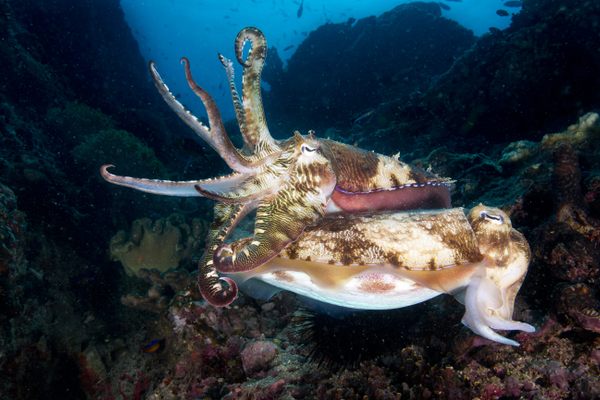Why Scientists Are Studying the Dining Habits of Manta Rays
These filter feeders might be a ray of hope amidst microplastic pollution.

Few have watched a manta ray glide through the ocean, fins flapping, mouth agape, without getting chills. The oft-open-mouthed, filter-feeding fish makes us wonder if magic is real. It also makes us wonder, what gets in that mouth? And where does it all go?
At California State University, Fullerton, assistant professor and researcher Misty Paig-Tran was asking the same question. After spending hours watching online videos of manta rays feeding, she couldn’t wrap her head around the mechanics of its mouth. The manta ray is a filter feeder, sifting microscopic plankton and small fish from the ocean as it moves through the water. “All previous research had reported that mantas use a sieving mechanism,” says Dr. Paig-Tran. “Think: Using a kitchen colander to separate pasta from water.” But inevitably, she points out, all sieves clog. “So what I was seeing didn’t jive with what I knew about the mechanics of sieving.”
If your lunch is reliant upon floating through your environment with an open mouth, you’d better have a way to prevent major food clogs. From baleen whales to bivalves, filter feeders utilize a wide variety of solid-fluid separation mechanisms that circumvent this. According to the New York Times, the basking shark is a classic “siever” with a curious unclogging mechanism. Once it’s done the sorting, it dislodges the pileup of coveted flotsam by closing its mouth and delivering a kind of body-quaking “cough.” But the ever-moving manta ray doesn’t do this—no cough, no clearing of the throat, no Heimlich maneuver.
Instead, Dr. Paig-Tran’s team discovered, manta rays possess a unique, complex filtration system that allows particles to drift over its biological straining system, rather than getting stuck in it. If you were to have the great fortune of peeking into the manta’s mouth, you’d see rows of leaf-like, angled lobes that look like slats. When the seawater flows in, tiny, swirling whirlpools form between each pair of slats, pushing the plankton upwards and away from the filters, so that they can be gulped down by the ray.
“It’s kind of like a pinball machine,” says Dr. Paig-Tran. “The particles slam into the filters and bounce off in another direction, in this case toward the esophagus while the water exits out the gill slits.”
According to the scientists, this kind of “ricochet separation” could provide important information about exactly what manta rays feed on—something that remains a bit of a mystery to marine biologists.
But, more curiously, this non-clogging filtration could have huge potential for engineers hoping to design more effective filters—from sustainable wastewater management systems to more efficient vacuum cleaners. According to Dr. Paig-Tran, harnessing the physics of ricochet separation might offer a novel way to filter microplastics from water in treatment plants, and provide better filtration in the food and beverage industry.
“I didn’t set out to find a new type of filtration or better human existence, even though that’s where the study led,” says Dr. Paig-Tran. Rather, she says, this study arose from looking at nature and asking a question. “There’s a big push, especially in politics, to get rid of “wasteful” spending for research that doesn’t appear to have direct human impact. But imagine all the ways nature has solved problems that we still haven’t fully explored.”
Gastro Obscura covers the world’s most wondrous food and drink.
Sign up for our regular newsletter.









































Follow us on Twitter to get the latest on the world's hidden wonders.
Like us on Facebook to get the latest on the world's hidden wonders.
Follow us on Twitter Like us on Facebook